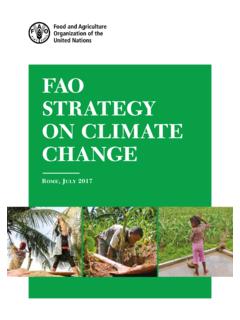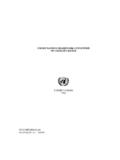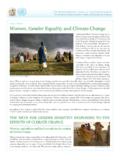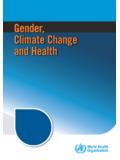Transcription of Flood and Coastal Defence Appraisal Guidance …
1 Page 1 of 9 Department for Environment, Food and Rural Affairs October 2006 Flood and Coastal Defence Appraisal Guidance FCDPAG3 Economic Appraisal Supplementary Note to Operating Authorities climate Change Impacts October 2006 1 Introduction and Background climate Change impacts on flooding and Coastal erosion are a challenge and risk for Defra and Operating Authorities ( Environment Agency, Local Authorities and Internal Drainage Boards). These impacts are well documented and include sea level rise and the potential increase in intensity, severity and frequency of Coastal storms, and rainfall events affecting flooding in fluvial catchments and urban surface water systems.
2 On sea levels for example, the period from 1960 to 1996 brought a rise of around 50mm at Lowestoft1. These impacts were captured in the 2004 Foresight report. Since the 1980s, Defra s response to such impacts has been as follows: promote policy Guidance , based on appropriately precautionary allowances and sensitivity testing to enable Operating Authorities to take climate change impacts into account in planning, Appraisal , decision making and operations; undertake an ongoing programme of related research in association with the Environment Agency and building on the work of other key research areas, notably from the Intergovernmental Panel on climate Change (IPCC) and from UK climate Impacts Programme (UKCIP).
3 Ensure Guidance is kept under review as further understanding of the likely impacts of climate change develops. In Making Space for Water (MSfW), Defra undertook to review the existing Guidance on climate change as part of a wider ranging review of Appraisal Guidance in 2007. This supplementary note therefore provides interim policy Guidance prior to the wider ranging review in MSfW and supports the publication of Planning Policy Statement 25 (PPS25) Development and Flood Risk . 2 Updated climate Change Policy For Flood and Coastal Management Background FCDPAG13 sets out the basis for considering climate change.
4 Detailed sea level rise allowances are also recommended in FCDPAG33 . FDCPAG43 also set out advice on sensitivity testing. In April 2003, a supplementary note on climate change built upon the earlier FCDPAG Guidance and updated precautionary allowances for sea level rise, together with sensitivity allowances for increased river flows; extreme rainfall, increased wave heights, and high and extreme wind speeds. Prior to the supplementary note issued in April 2003, a further supplementary Guidance note was issued in March 2003, which recommended whole life appraisals typically of 75-125 years, reflecting Treasury Green Book changes.
5 This led to a need to consider longer term timescales, together with the inevitable longer term effects of climate change. The allowances and sensitivity ranges covered in this note therefore cover up to year 2115. In addition, this note covers changes to reflect most recent findings, such as in land movement2 and the effects of thermo-expansion of the sea. Whilst acknowledging the updates to allowances in recent years, climate change advice in the FCDPAG3 documents is still relevant, particularly regarding: uncertainty, natural variability, flexibility in design, sensitivity analysis and ocean circulation changes. Research4 ongoing within the Joint Defra/EA R&D programme5, with a focus on improving Flood and Coastal management policy on 1 DETR (1999) Indicators of climate Change, Section 9 Sea Level Rise 2 UKCIP (2005) Updates to Regional net sea-level change estimates for Great Britain.
6 3 FCDPAG1 (2001:21); FCDPAG3 (1999:43)); FCDPAG4 (2000:15) Page 2 of 9 Department for Environment, Food and Rural Affairs October 2006 climate change impacts, will continue to improve our knowledge of the impacts, and policies will be adjusted as required, in future. Additionally, policies may be updated in the light of revised sea level rise information from IPCC, and any new approaches emerging from UKCIP. Aims In considering the context and background, and in covering England and Wales, this interim note on climate change policy aims to: Inform appraisers and decision makers of new climate change allowances and sensitivity ranges, and broadly how these should be applied.
7 Remind appraisers and decision makers that Defra expects this supplementary Guidance note to be applied to all future appraisals, strategies and management plans that are started from October 2006. However, practitioners and managers should be diligent to take on this Guidance for work in progress, where it is clearly in the best interests of longer term outcomes and policies. For consistent approach, most projects should use the recommended allowances and sensitivity ranges, ensuring that projects make provision for future changes in a consistent way and provide a valid basis for comparing investments. A managed approach is strongly recommended for public funded Flood and Coastal activities, to avoid any overly cautious responses and any knock-on affordability implications in the short term.
8 An exceptional reason would be necessary to not apply this Guidance on public funded Flood and Coastal management activities. This Guidance should also be referred to when using PPS25 Annex B on climate change. Regional sea level allowances The new allowances are shown in Table 1. Key points to consider are as follows: Net sea level rise allowances incorporate thermal expansion of the oceans and melt from land glaciers and vertical adjustments of the land. Additional contributions from tidal surge and waves are not included. Global mean sea level rise projections up to the 2080s were taken from the Intergovernmental Panel on climate Change (IPCC) Third Assessment Report (TAR) High estimates.
9 Global mean sea level rise projections for the 2110s were extrapolated from the 2020s, 2050s and 2080s. Regional variations in net sea level rise allowances reflect latest information on vertical land movements6. The baseline for calculating sea level rise for a given year is taken from 1990. There are significant uncertainties in climate change predictions and there may be studies that suggest allowances could be higher (for example, research from Thames 2100). However, figures in this supplementary Guidance are considered most appropriate for Flood and Coastal risk management and planning, and should be used until further updates are provided.
10 For more detailed information on assumptions and references associated with the new allowances, please refer to Annex A1. 4 FD2020 project Regionalised impacts of climate change on river flows; and MAR Project Development and dissemination of information on Coastal and estuary extremes. 5 http://defraweb/environ/fcd/ 6 Shennan, I. And Horton, B. (2002). Holocene land- and sea-level changes in Great Britain. Journal of Quaternary Science, 17, 511-526. Page 3 of 9 Department for Environment, Food and Rural Affairs October 2006 Table 1.





